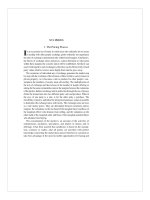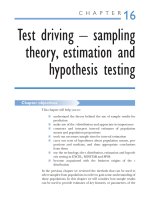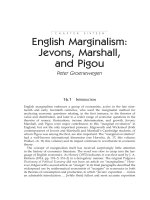micro economics chapter 16
Bạn đang xem bản rút gọn của tài liệu. Xem và tải ngay bản đầy đủ của tài liệu tại đây (208.65 KB, 30 trang )
16
Interest Rates and Monetary
Policy
McGraw-Hill/Irwin
Copyright © 2012 by The McGraw-Hill Companies, Inc. All rights reserved.
Definitions
Total (Actual) Reserves: Amount of money a
bank holds (has available).
Total Reserves = Required Reserves
Excess Reserves
+
Required Reserves: Fraction of actual reserves
a bank must keep (can’t be loaned).
Reserve Ratio: Percentage of demand deposits
bank must maintain for required reserves.
LO1
Definitions
Excess Reserves: Amount of actual
reserves the bank has to loan.
Excess Reserves = Total Reserves –
Required Res.
Monetary multiplier (m) =
1/Reserve Ratio
LO1
Interest Rates
• Price paid for the use of money
• Many different interest rates
• Speak as if only one interest rate
• Determined by money supply
and money demand
LO1
Central Banks
LO2
Tools of Monetary Policy
Monetary policy is the
manipulation of the money
supply by changing bank’s
excess reserves.
LO1
Tools of Monetary Policy
Four tools of monetary policy
1.Open market operations
2.The required reserve ratio
3.The discount rate
4.Interest on reserves
LO1
Tools of Monetary Policy
• Open market operations
• Buying and selling of government
securities (or bonds) by the Fed
• Most important tool to change the
money supply
LO2
Tools of Monetary Policy
To increase Sm, Fed can buy
securities from bank or public.
I.E. Fed buys $1,000 security from
commercial bank, reserve ratio is
20%.
LO2
Tools of Monetary Policy
• Fed pays for securities by
increasing bank’s actual reserves
by $1,000.
• Since bank doesn’t have to
maintain required reserves for
money from Fed, excess reserves
increase by $1,000.
LO2
Open Market Operations
• Money creating potential of single
bank is equivalent to its excess
reserves (amount it can loan).
• Bank’s money creating potential
increased by $1,000.
LO2
Open Market Operations
• Money supply increases by $5,000
(5 x 1,000)due to monetary multiplier.
• Change in Sm = m x change in excess
reserves
LO2
Open Market Operations
• Fed buys $1,000 security from public,
reserve ratio is 20%
• Fed pays with $1,000 check – money
supply is directly increased by $1,000.
LO2
Open Market Operations
• Check is deposited and bank’s actual
reserves rise by $1,000.
• Required reserves increase by $200.
(.2 x $1,000)
• Bank’s excess reserves rise by $800.
($1000 - $200)
• Bank’s lending ability increases by
$800.
LO2
Open Market Operations
• Banking system’s money creating
potential increases by $4,000 (5 x
$800).
• Money supply increases by $5,000
$4,000 + $1,000 (initial check).
LO2
Repos and Reverse Repos
• Collateralized loans
• Repo transaction – Fed loans money
in exchange for government bonds
used as collateral.
• Reverse Repo – Fed borrows money
from financial institutions and uses
government bonds as collateral.
LO2
Tools of Monetary Policy
• The reserve ratio
• Changes the money multiplier
• Reduce reserve ratio to increase
money supply
• Increase reserve ratio to reduce
money supply
LO2
Tools of Monetary Policy
•
LO2
The discount rate – Lender of Last
Resort
• Interest rate on loans from Fed to
banks
• Lower discount rate to increase money
supply
• Increase discount rate to reduce
money supply
Tools of Monetary Policy
•
LO2
Interest on reserves – law changed
2008
• Increase interest rate on reserves
• Banks will leave more reserves with
Fed
• Decrease money supply
• Decrease interest rate on reserves
• Banks will leave fewer reserves with
Fed
• Increase money supply
Tools of Monetary Policy
• Reserve ratio changes bank’s
•
•
LO2
profitability
Discount rate is a passive tool
until financial crisis
Interest on reserves is too new
The Federal Funds Rate
• Rate charged by banks on overnight
•
•
•
LO3
loans
Targeted by the Federal Reserve when
changing the money supply
Prime interest rate is directly related
to the Federal funds rate.
Prime interest rate is charged on
loans to most credit-worthy customers
Monetary Policy
LO3
Monetary Policy
• Expansionary monetary policy
• Economy faces a recession
• Increase money supply, interest rates fall
• Lower target for federal funds rate
• Fed buys securities
• Lower reserve ratio
• Lower discount rate
• Decrease interest on reserves
LO3
Expansionary Policy after Debt
Crisis
• Trillions of dollars in excess reserves
• Zero lower bound problem
• Economy didn’t expand, interest rates already at
zero
• Negative nominal interest rates
• Deposits withdrawn from banking system
• Less money for banks, decrease in money supply
• Quantitative easing
• No impact on interest rates
• Increases excess reserves of banks
LO5
Monetary Policy
• Restrictive monetary policy
• Periods of rising inflation
• Decreases money supply, interest rates rise
• Increase target Federal funds rate
• Fed sells securities
• Raise reserve ratio
• Raise discount rate
• Increase interest on reserves
LO3









